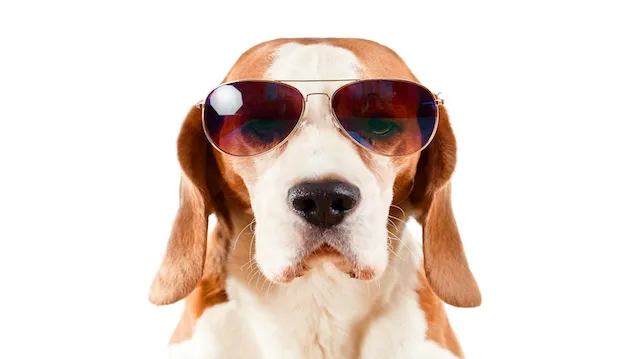Many hound breeds are named for their original quarry, for example, the foxhound, coonhound and deerhound. Despite the fact that these dogs were bred for hunting, most of them make very good house pets and couch hounds.
Scent versus sight hounds
Hounds fall into two primary groups — scent and sight hounds. The former tracks their prey via their noses, and their sense of smell rules their lives. Common scent hound breeds include the following:
- basset hound
- beagle
- bloodhound
- dachshund
- coonhounds, including the black-and-tan, Treeing Walker, redbone and bluetick
Sight hounds, also known as gaze hounds, go after quarry based on visual stimulus. These canines characteristically pursue prey in short bursts of tremendous speed. The greyhound perhaps best embodies these qualities. Other well-known sight hound breeds include the following:
- Afghan hound
- borzoi or Russian wolfhound
- Irish wolfhound
- Rhodesian ridgeback
- Scottish deerhound
- whippet
One thing both types of hounds have in common is an independent streak. They aren’t the easiest dogs to train, but patience and persistence will get you there.
Since hounds were originally bred to live in packs; most hounds get along well with other dogs. However, while scent hounds usually tolerate cats, that’s not the case with sight hounds, which see felines and other smaller pets as prey. Scent hounds generally get along very well with kids, while sight hounds are extremely loyal to their person or family.
Baying, not barking
While sight hounds generally bark like other dogs, that’s not the case with many scent hounds. Instead, these canines bay, a sound that hound lovers call “music.” Quite simply, baying is howling, not barking. In the field, it lets hunters know that hounds are on the scent. At home, it’s the substitute for barking, so your hound will bay to let you know that he wants to come back inside, or that there’s a squirrel in the yard.
Although these dogs readily notice and bay for prey, not so for humans. With some exceptions — such as the dachshund — most scent hounds are not good watchdogs. Sight hounds are far better home guardians than their scent-centric brethren.
Hound aroma
Scent hounds share another distinction. Many of them emit a musky scent that isn’t entirely unpleasant but definitely smells like dog. Regular bathing and feeding a high-quality dog food can tone down the odor, but it’s tough to eradicate completely. On the plus side, besides bathing they won’t require much in the way of grooming since most scent hound breeds have very short coats and don’t shed excessively.
Basic training
There are a few challenges involved in training a hound. Because of their natural independence, hounds aren’t as eager to please as more obedient types, like the Labrador retriever or poodle. Then, there are the constant distractions of smell or movement.
Approach basic training — walking on a leash, sitting, staying and coming when called — a bit differently with a hound. Use a very long leash during training, as hounds tend to wander. Keep training sessions short, no longer than five minutes, or your hound will get bored.
Food rewards let the dog know he’s performed properly, and are a good incentive. You can try smearing peanut butter or a similar tasty food on your fingers when training your dog. When he obeys, he not only receives praise but a scrumptious treat mixed with your scent.
House-training
Housebreaking can also take longer with some hounds, especially scent hounds. Take your hound out frequently, and praise him when he “does his business.” Clicker training is useful, as he associates the “click” with a treat when he has urinated or defecated outdoors.

Hound precautions
Because of their strong chase and prey drive, it’s never a good idea to let your hound off-leash when you’re out for a stroll. One whiff of a rabbit or sight of a squirrel is enough to get them off and running, leading to a dangerous situation. Scent hounds especially are apt to practice selective hearing when you try to call them off a trail.
While all dogs need proper identification in the forms of collar tags and microchips, it’s especially necessary with hounds, since they can roam very long distances once they get loose.
Fun with hounds
There’s no reason a hunting hound can’t make a good house pet. For people who don’t hunt, there are plenty of fun and important activities you can engage in with your hound. Maybe he won’t shine at obedience, but there are many other areas in which he can excel.
Hounds with basic obedience skills often make good therapy dogs; who can resist the beautiful, pleading eyes of a beagle? Scent hounds can excel at search-and-rescue. Bloodhounds are routinely used by law enforcement to track criminals or missing persons, and you might have spotted beagles at work in airports sniffing at luggage for drugs and other contraband.
With so much to enjoy about these unique breeds, adding a hound to your family can be a fun adventure for everyone.
—Jane Meggitt
Jane Meggitt graduated from New York University and worked as a staff writer for a major New Jersey newspaper chain. Her work on pets, equines and health have appeared in dozens of publications, including The Daily Puppy, The Nest Pets, Horse News, Hoof Beats and Horseback magazines.
Sources:
http://www.akc.org/dog-breeds/groups/hound
http://www.vetstreet.com/our-pet-experts/tips-for-training-scent-and-sight-hounds
https://www.petcarerx.com/article/how-to-potty-train-basset-hounds/452
